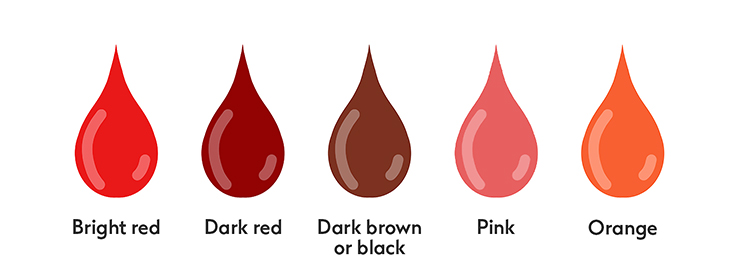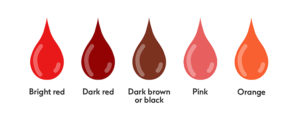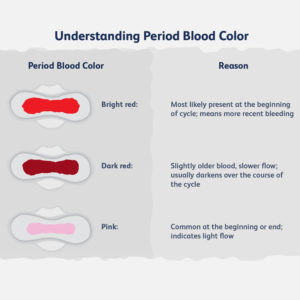What Your Period Blood Says About Your Body?

How do you analyse that your menstrual cycle is normal? Usually, women consider the number of days the period lasts, the flow and sometimes they might also consider the diet and physical activities to analyse their periods. But what if I tell you, the colour and composition of your period blood can actually say a lot about your body!
 Yes, you read that right. Most women have high chances of experiencing great changes in the colours and textures of their menstrual blood. These changes in the period blood and texture can indeed say a lot about your menstrual cycle. We have gathered a list of changes that your period blood can display and what they mean for you to have a better understanding.
Yes, you read that right. Most women have high chances of experiencing great changes in the colours and textures of their menstrual blood. These changes in the period blood and texture can indeed say a lot about your menstrual cycle. We have gathered a list of changes that your period blood can display and what they mean for you to have a better understanding.
- Bright Red
Bright red colour indicates a healthy and normal period. For most of the women, a period starts with a bright red or dark red colour. This bright red colour always means the flow is normal and the blood is fresh so you have nothing to worry about. Although, some women also observe dark red colour as in blackish red, which is a sign of old blood.
However, in some cases, you might observe bright red bleeding between menstrual cycles which is a clear sign of sexually transmitted infections. Besides, growths in the uterine lining ( polyps/fibroids) can also be a major cause of unusually heavy bright red bleeding.
- Reddish Brown Blood
Out of all shades, reddish-brown is a sign of old blood. Basically, when your flow is slow, the blood may take longer to exit your body. Now, this makes the blood stay in the uterus for a longer time, turning the shade from a bright red to reddish-brown colour. In addition to that, pregnant women after childbirth might as well experience the discharge of reddish-brown blood.
Talking about pregnancy, discharge of reddish-brown blood before childbirth is usually a sign of miscarriage. If this is the case, then it’s a good call to consult a doctor.
- Pink Blood
Most of the women might not be aware of a pink discharge, as it’s very rare to occur. Generally, pink blood occurs to women who experience spotting. In that case, the blood may appear pink in colour at the beginning or end of the period. In addition to that, if a woman indulges in hormonal birth control then there’s a pretty good chance of having a lighter blood flow with a pinkish hue during periods.
Sometimes, pinkish blood might be a sign of low estrogen levels in the body. Basically estrogen levels stabilize the uterine lining, and without this hormone, one may shed the lining at times throughout your cycle, which leads to the spotting of various colours, including pink.
- Orange Blood
If your period blood has an orangish tint to it, but the consistency and scent don’t seem any different from your usual period blood, it’s most likely nothing to worry about. However, if the texture or scent is off, these can be symptoms of a sexually transmitted disease or infection (STD/STI). If this is the case, make a trip to your doctor’s office ASAP.
- Grey Colour Blood
In almost all the cases, grey or off-white discharge is a sign of vaginal infection! It can also be a cause of a condition that occurs due to an imbalance between beneficial and harmful bacteria in the vagina. If you ever observe itching in and around the vagina and foul veginal odour along this grey discharge then it is a clear indication of bacterial vaginosis. Another explanation for grey discharge is, if you are pregnant, it is a sign of miscarriage. Either way, it’s best to consult a doctor before something gets serious.
- Purple Blood
Most of us wouldn’t be expecting to see dark purple or blue down there, but hey, sometimes it happens. Sometimes too much estrogen levels can lead to purple colour discharge. In short, you need to incorporate more fibre into your daily diet. Another reason for purple discharge is when you experience period clots or clumps, for which you have nothing to worry about. Make sure you take fibres as in tasty snacks like raspberries, pistachios, avocado, carrots, sweet potatoes and others. These dietary adjustments might help you fix the purple bleeding. It’s always a good idea to contact a gynaecologist regardless.
The colour, texture and flow of period blood can provide useful information about a woman’s overall health. However, every human body is different, and blood can change colour and consistency during a period and from month to month. So it’s really important for one to know what is normal for them.
 In fact, it is well recommended to have regular check-ups with a gynaecologist to help you with your queries. This way, you’ll be able to learn and understand about your periods and know how to normalise them.
In fact, it is well recommended to have regular check-ups with a gynaecologist to help you with your queries. This way, you’ll be able to learn and understand about your periods and know how to normalise them.
- Why the Right Bra Matters for Heavy Breasts - December 19, 2025
- 5 Attractive Nighties to Make Your Wedding Night Unforgettable - December 18, 2025
- Knock-Knock, High Time to Know – What Is the Right Age to Wear a Bra? - December 17, 2025






